The Bièvres International Photo Fair was something of a record, at least for me. I bought nothing, not even a €15 folding camera for my display shelf. No, I had a will of steel and concentrated instead on the social aspects and taking a few atmospheric shots for this article.
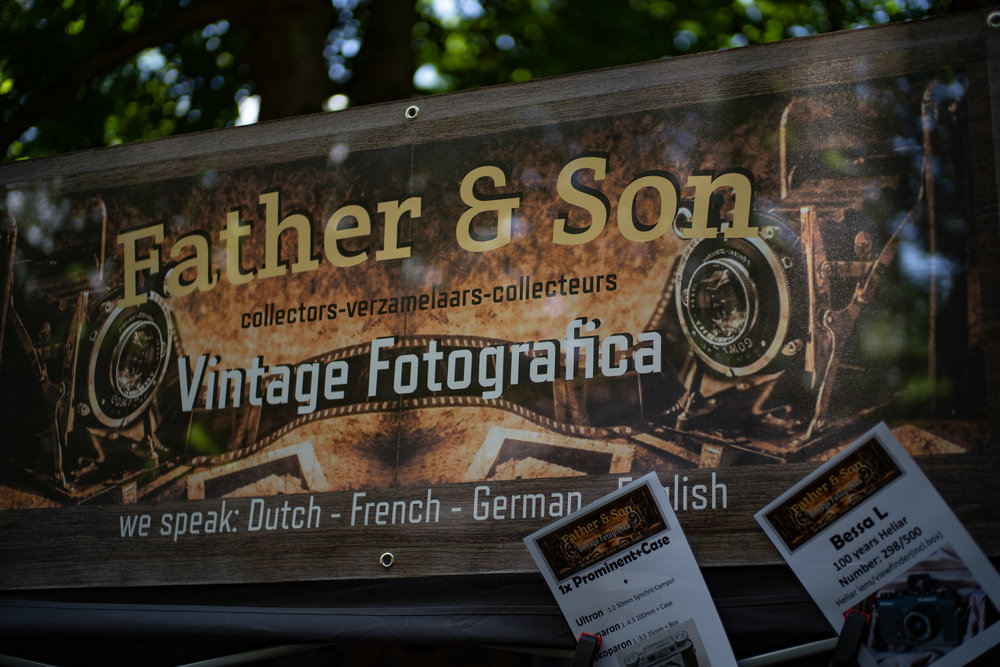
The social side of Bièvres is important. It’s an opportunity to meet many friends from Britain, including a big swathe of dealers, eager to buy for stock, and regular visitors from the USA, Europe and the Far East. One collector we know flew in from China for the day and straight back the following morning. That’s enthusiasm for you. I trust that he didn’t go back empty-handed.
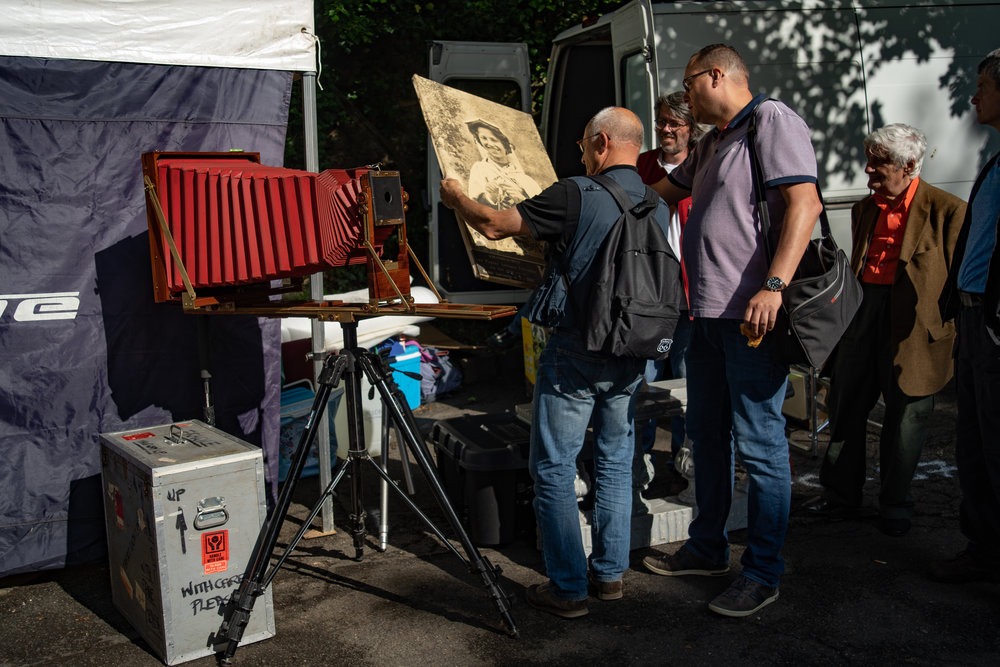
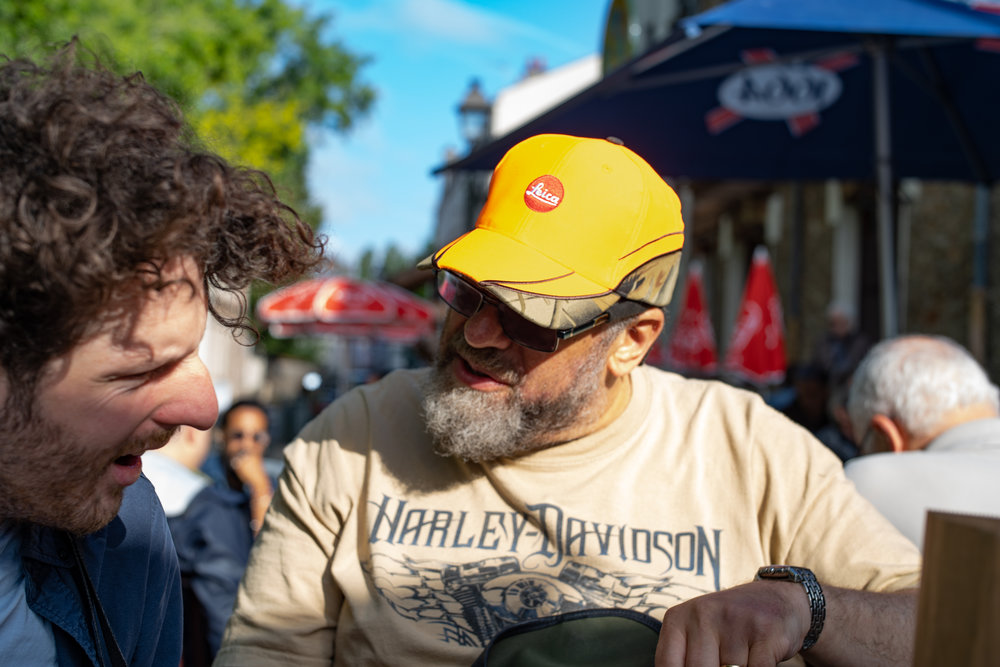
Social
Perhaps the greatest pleasure is that most of the British contingent usually stay in one hotel, about five miles’ distance from Bièvres. This year, because of an unfortunate double booking (not our fault), the hotel unceremoniously split us into two locations. Together with the contingent from Red Dot Cameras and David “Woody” Woodford of MW Classic Cameras, I was consigned to the new hotel. As a result, we missed the opportunity to go out “en famille” for the traditional Saturday evening bash.
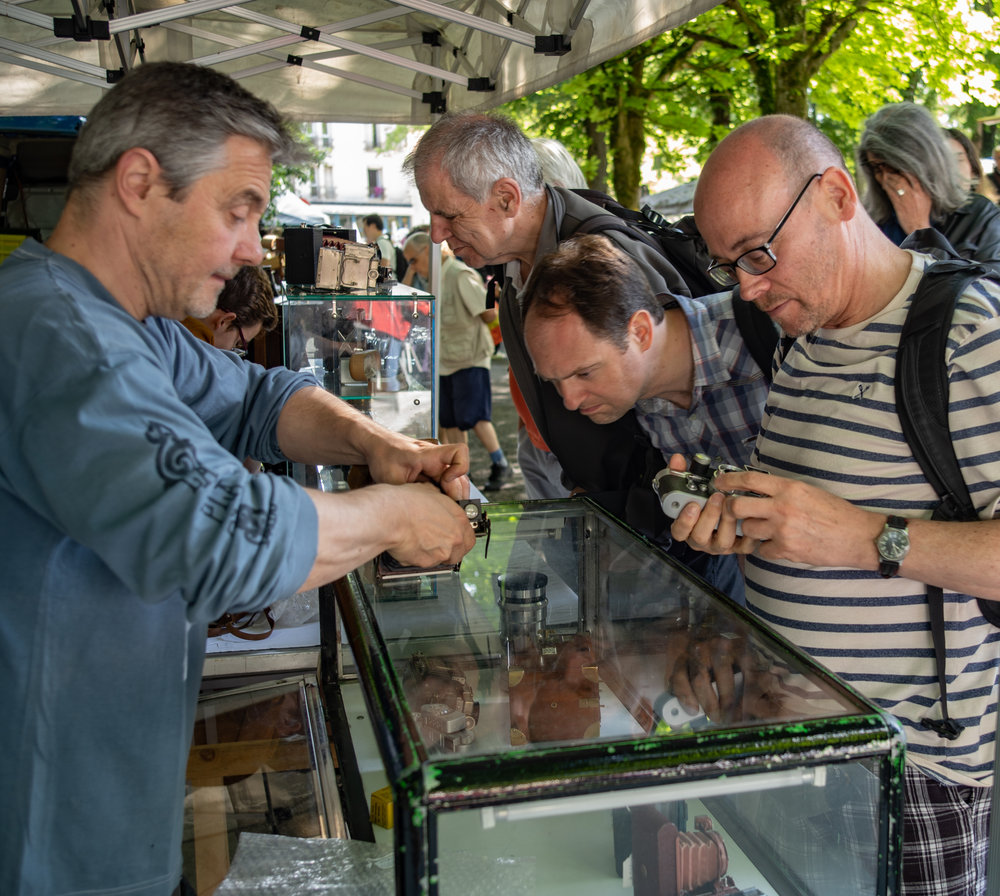
The fair turned out to be one of the best for weather in recent years and both days were hot and humid, with strong sunlight and heavy contrast. Unfortunately, this didn’t help photography. It did help business, though, and trade was brisk. From our point of view, there were no great bargains to be had because the pound is weak and prices were in many cases very little different from those in Britain. In previous years there were rich pickings for those dealers who got in early.
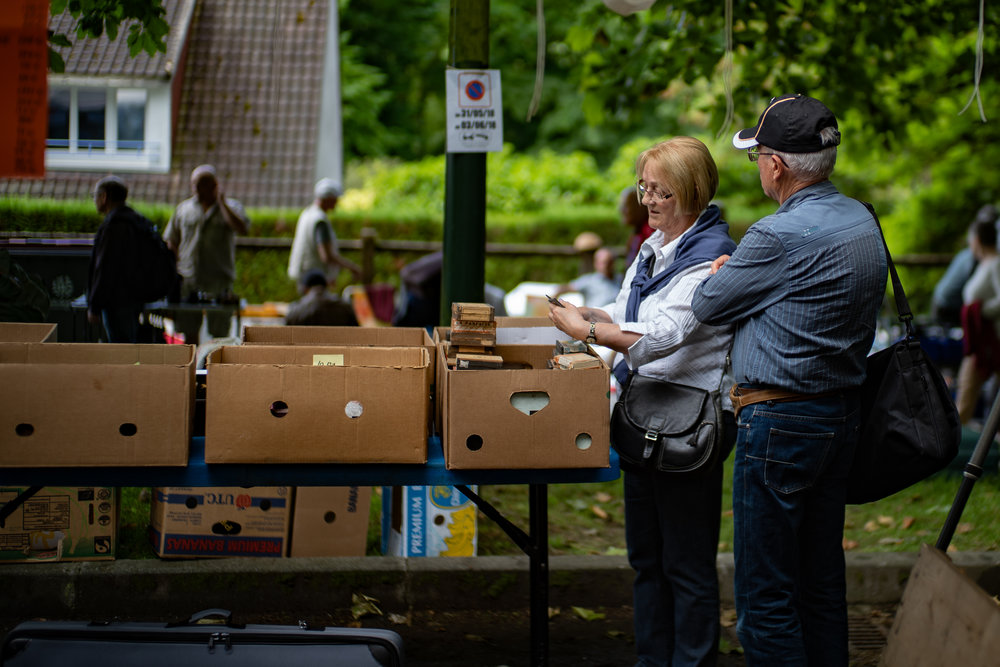
Even before the fair opened on Saturday, the foreign trade buyers were swarming all over the exhibitors as they unpacked their stock. As with most of these fairs, all the real bargains are snapped up within the first half hour and almost entirely by the trade. While prices for individual pieces of equipment were not particularly low, the dealers have the advantage of negotiating substantial discounts. If you are taking an exhibitor’s entire stick of M6 Classics you are bound to get a much better price than the individual buyer, however early the bird.
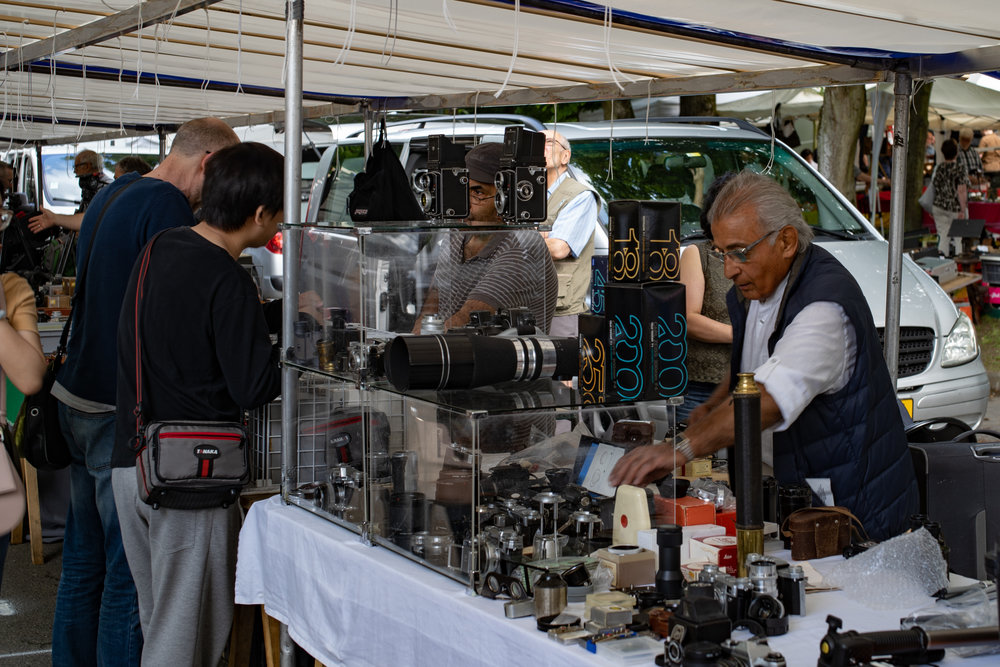
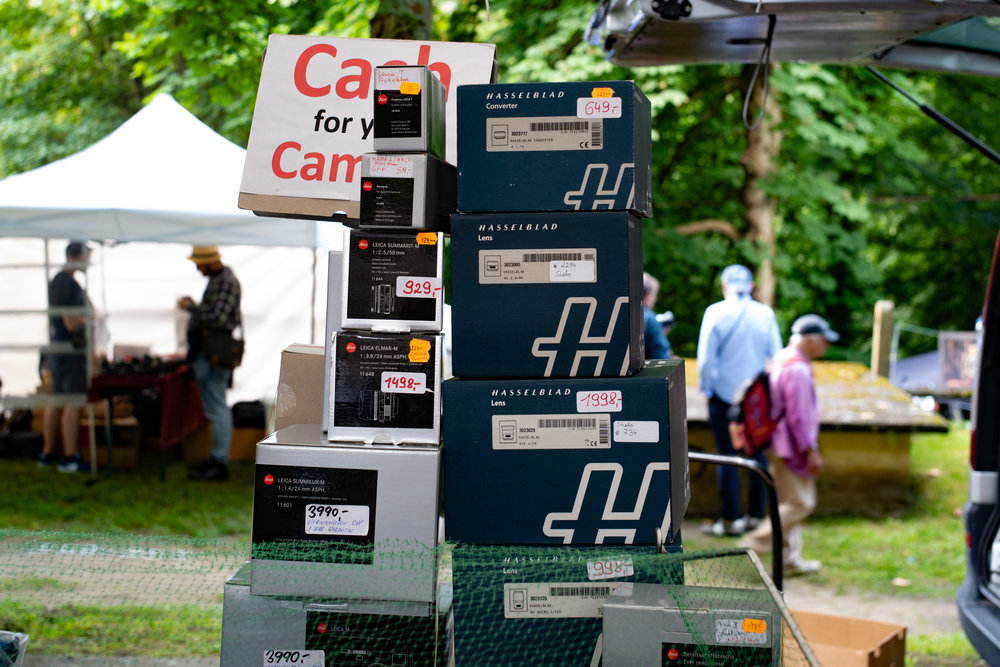

Bold as brass
A fair such as Bièvres covers every conceivable aspect of photography, but mainly film photography. Cameras range from the earliest wooden plate monsters through to the last Nikons, Canons, Contaxes and, of course, the ever-popular Leicas. There are specialists such as British dealer David Woodford who looks mainly for old brass lenses, for which there is an increasing demand from all over the world. Occasionally, a real bargain will turn up at Bièvres but, in the main, it is a matter of buying wisely with an eye to a small profit on resale. Some of these old brass lenses can cost in the tens of thousands.
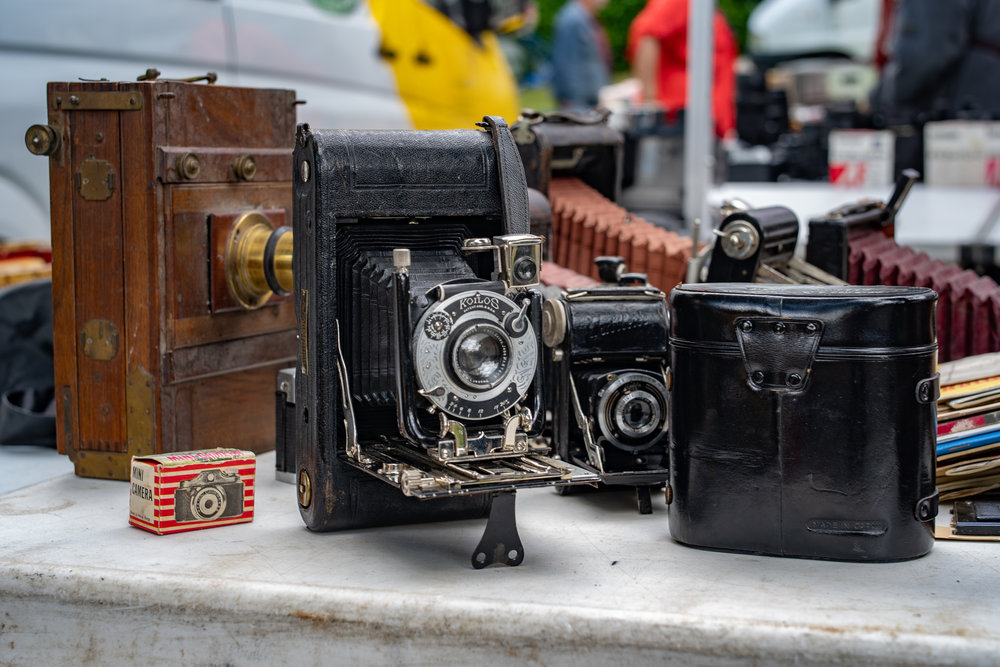
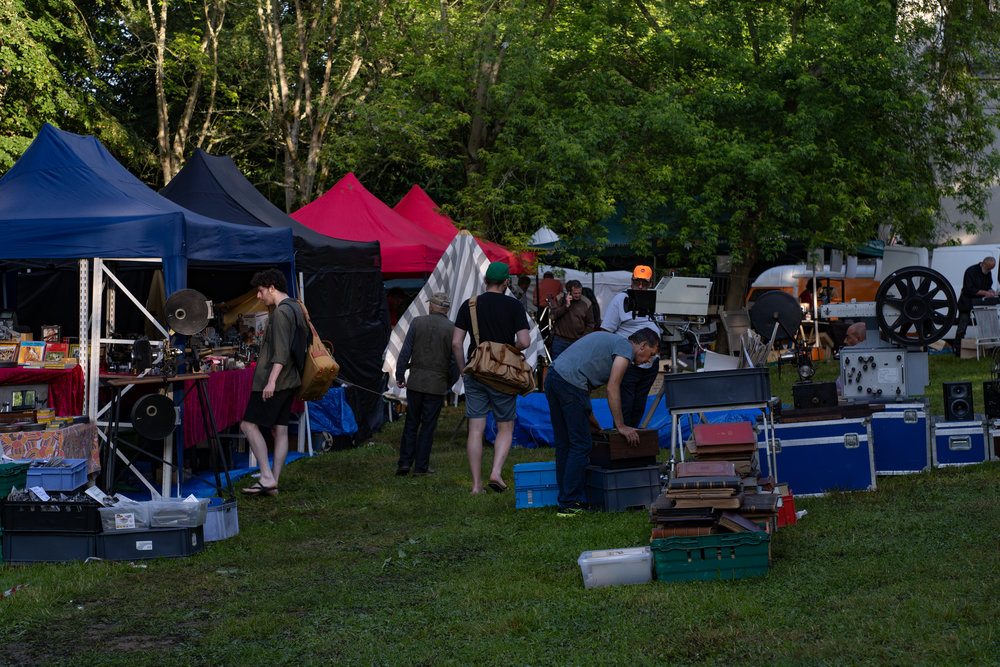
For me, the more familiar territory surrounds Leica M cameras. Biggest demand this year was for the M3, which is no surprise, but also for the M6 Classic and TTL which have been gaining in popularity (and price) over the past few years. There is still a surprising number of good examples turning up. Sometimes I wonder where they all come from. Because of the demand, I imagine that very few M cameras have been scrapped and almost all bodies produced are still churning around the trade year after year. I think of the same cameras turning up at Bièvres every few years and beginning the merry-go-round once again.
Below: Impromptu sales pitches. Some vendors set up a picnic patch on the grass, while unofficial traders advertise the contents of their backpacks as they walk around. Stop me and buy one is the order of the day. Some, such as the guy in the top right picture, come prepared to cart off their bargains
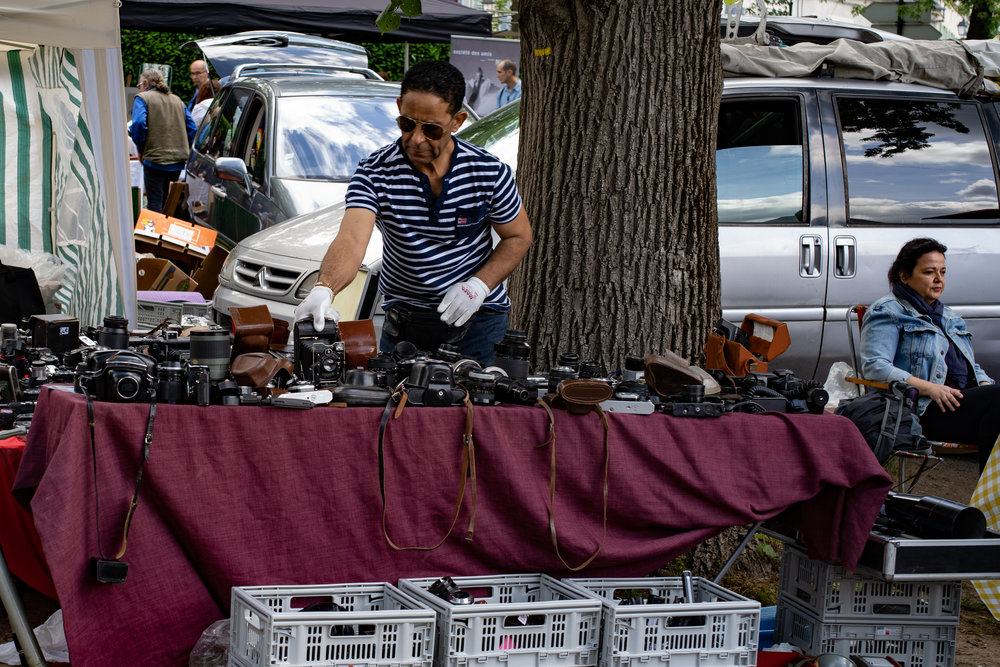
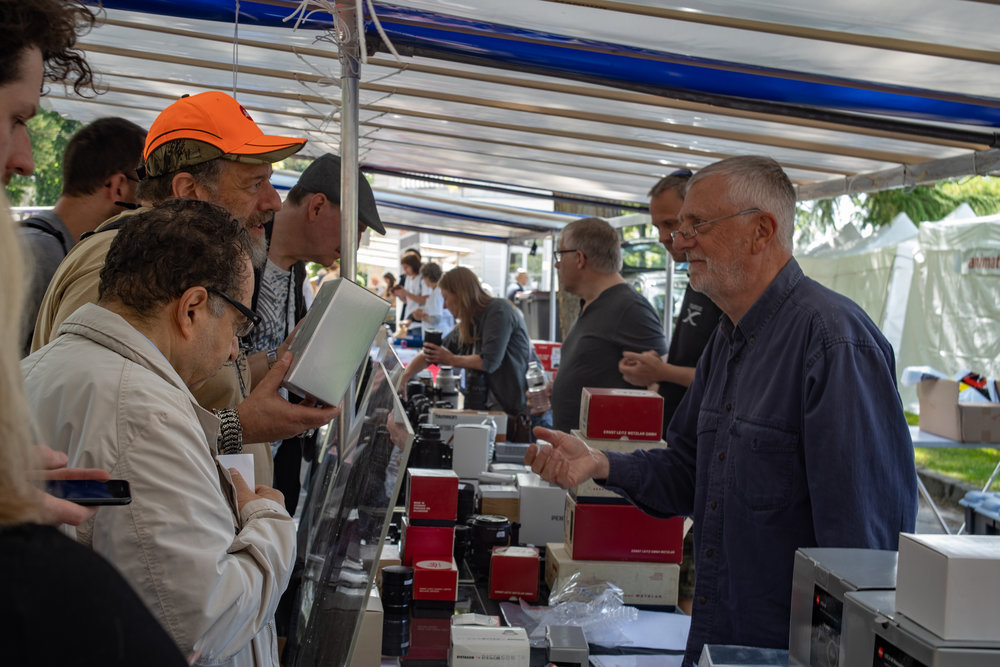
In among the vintage stuff and the serried ranks of used DSLRs is the occasional modern mirrorless digital body or lens to be picked up at a good price. This year there was also a special alley reserved for dealers in new cameras and lenses, including Fuji, Olympus, Panasonic, Sony, Canon, Nikon and Tamron. I made a few enquiries but, frankly, there was nothing there that I couldn’t have bought in London at a similar price. That was a bit disappointing and was another reason I managed to keep my money in my pocket.
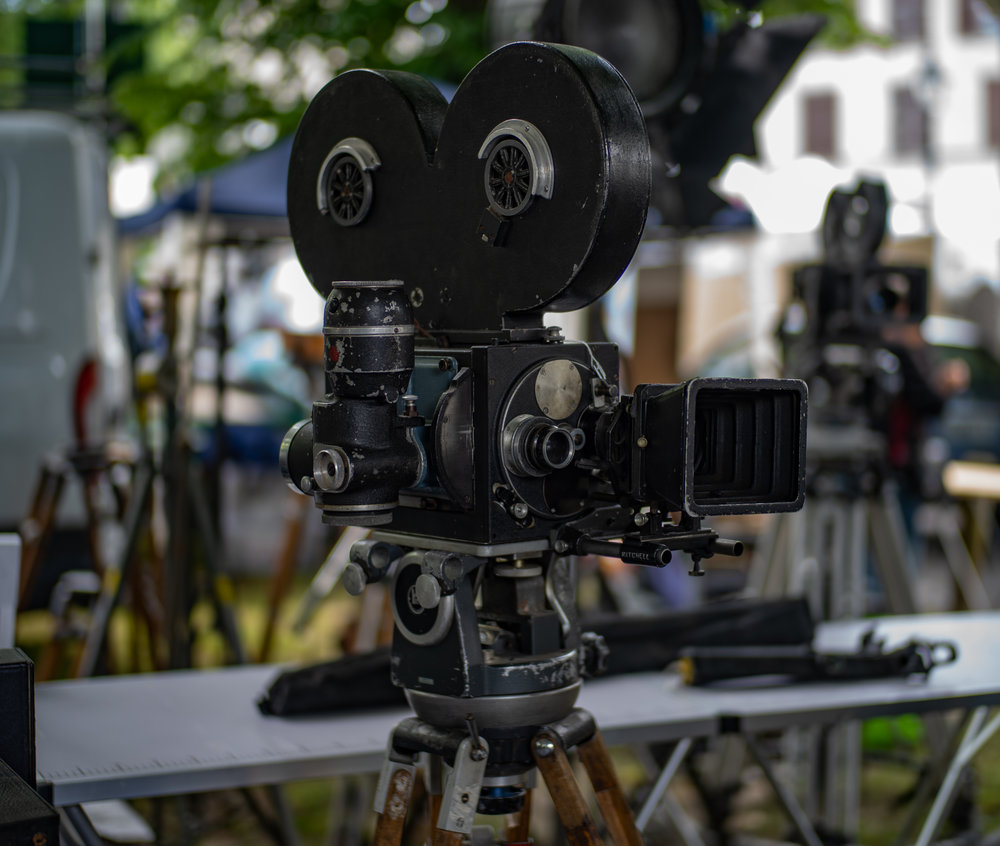
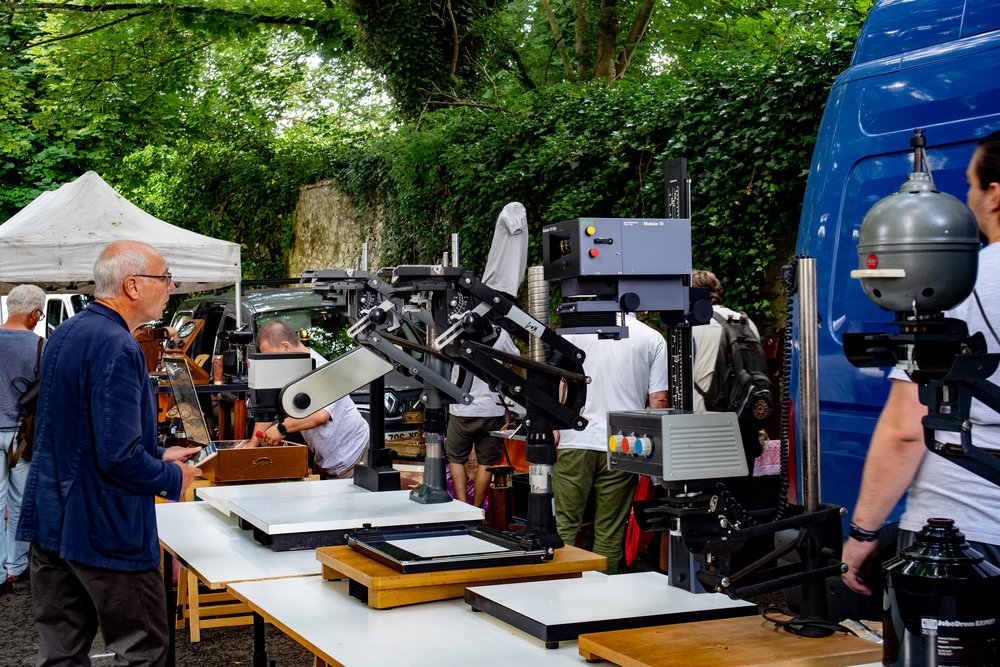
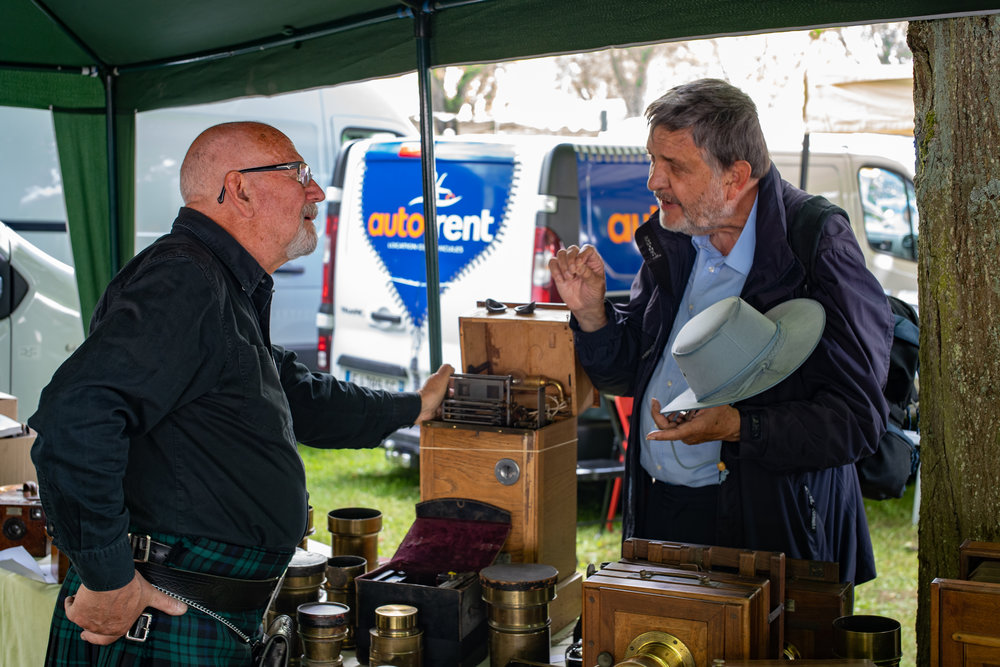
Sunday, which is the main day of the fair, is characterised by dozens of additional exhibitors selling vintage and modern prints. One of the regulars visitors from Germany, who I see every year, is interested only in Victorian and early 20th-century prints to add to his collection. Such are the specialisations among regular Bièvres fans.
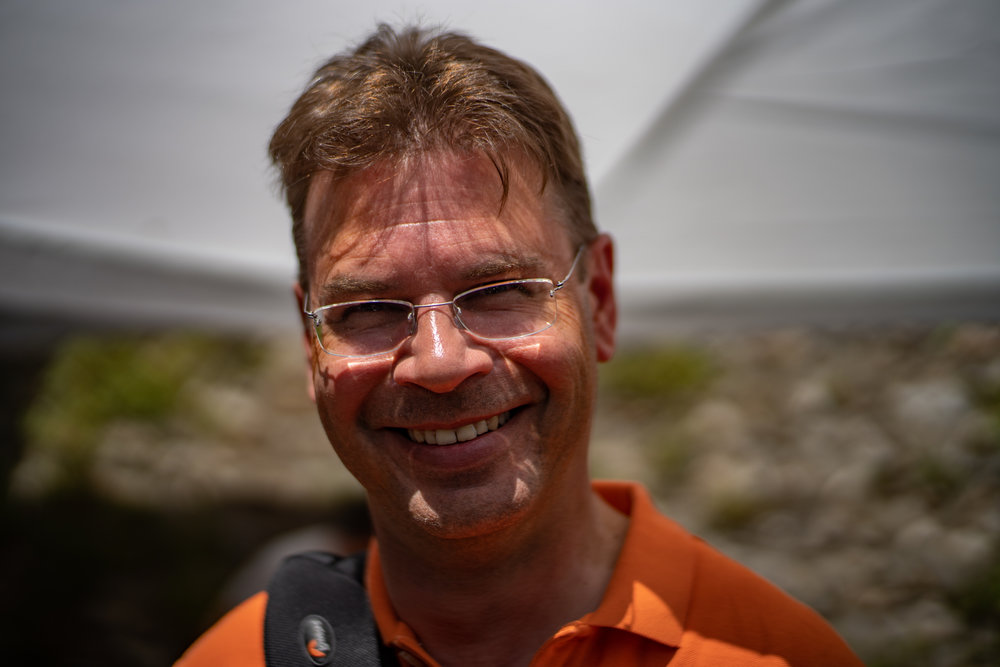
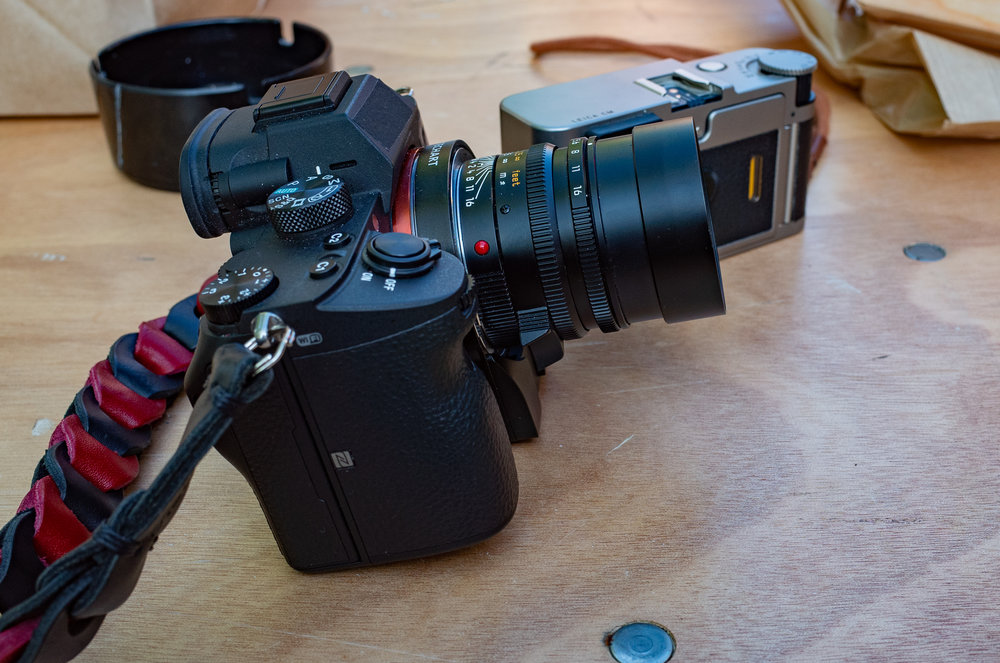
Sony and the AF Leica lenses
Apart from the little Ricoh GR, my constant standby, I relied this year entirely on the new Sony A7III, the Techart autofocus adapter and a trio of lenses — a Tri-Elmar MATE, 50mm Summilux and 75mm Apo-Summicron. I ended up using the Summilux most of the time but gave the other two a brief innings at the beginning and end of the weekend. The 50mm focal length proved ideal and I didn’t miss not having a zoom lens.

I will be reporting more fully on the Techart AF adapter when I have further experience, but by and large, it worked well. Occasionally, for some unknown reason, the camera would cease to lock on focus and this could be frustrating because it often happened at a crucial moment and I was left unable to focus the lens. I missed several good shots as a result.
When it did work, which was most of the time, the focus was quick and accurate and I found it a revelation to be using such a wonderful lens as the 50mm Summilux-M for quick AF shots. Both the above portraits of David and Francis were taken essentially as quick snaps, with the Techart successfully capturing the face in a fraction of a second, even at wide aperture. The ability to use the lens at wider aperture even in such sunny conditions is helped by the one-stop advantage — to 1/8000s — afforded by the Sony. It is, however, a disappointment that the camera does not have an electronic shutter. The new A9 offers a further two-stop advantage at speeds up to 1/32000s
I know there’s nothing special about autofocus and any modern camera and native lens will perform better than the Techart. Why not just put an AF lens on the Sony, you might ask. But for owners of manual lenses, who just occasionally might fancy a bit of auto, it is an intriguing and popular proposition.
Further investigation of this random error is needed. I suspect a firmware update in the Techart would do the trick. After all, the A7III is a new camera and it is highly likely the adaptor has not yet been optimised for the model. Reader David Babsky, who owns this particular Techart, uses it with an A7rII and has noticed no similar problems. We don’t want to update the firmware in case it causes problems for him. If it works, don’t fiddle…..
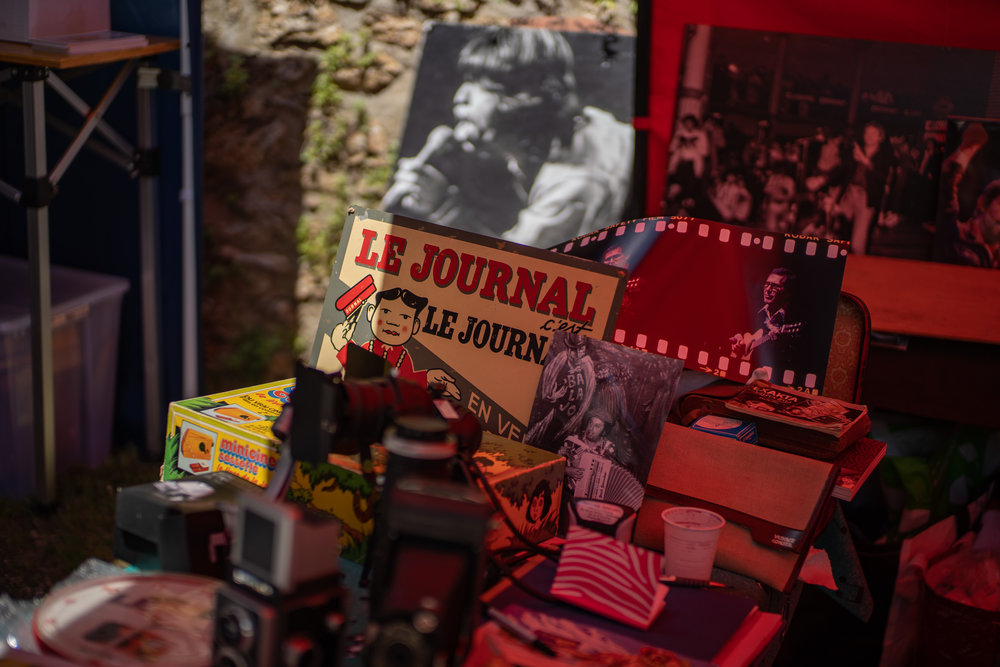
With thanks, as usual, to Anne Quemy and the team from the Club Paris Val-de-Bièvre for the efficient organisation and the excellent press facilities.
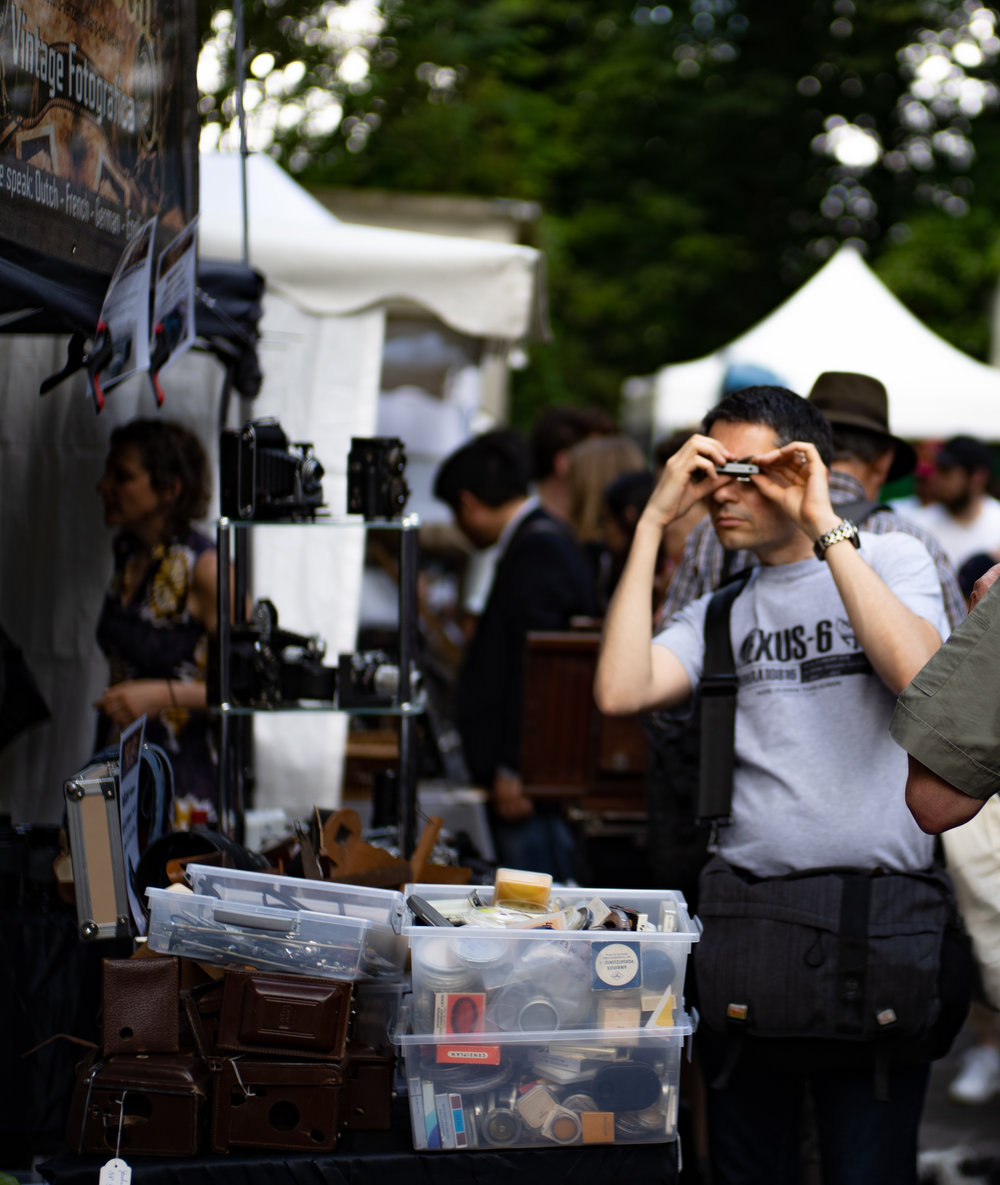
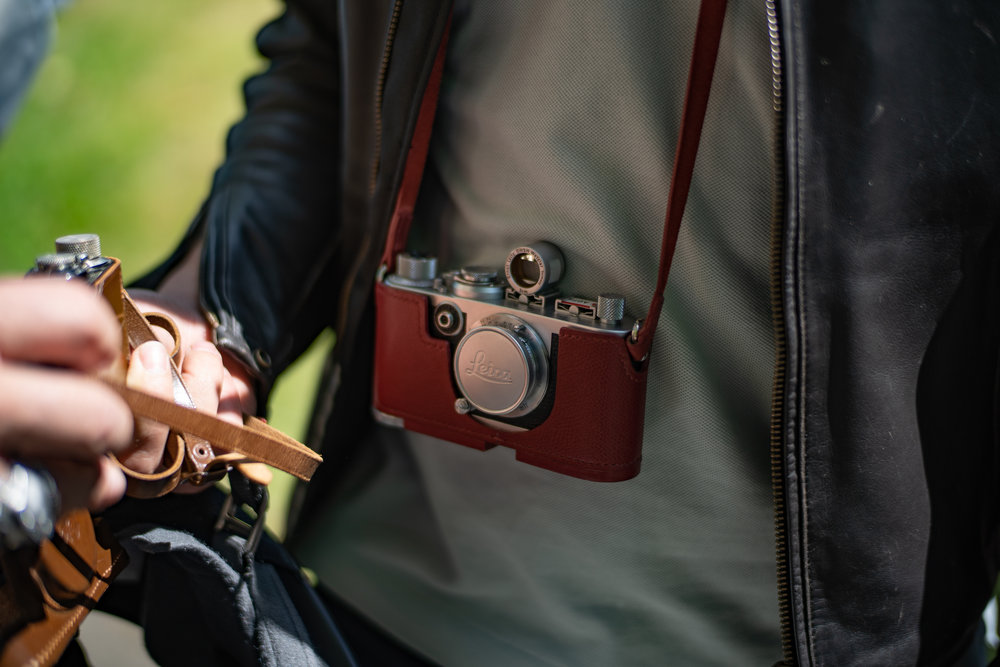
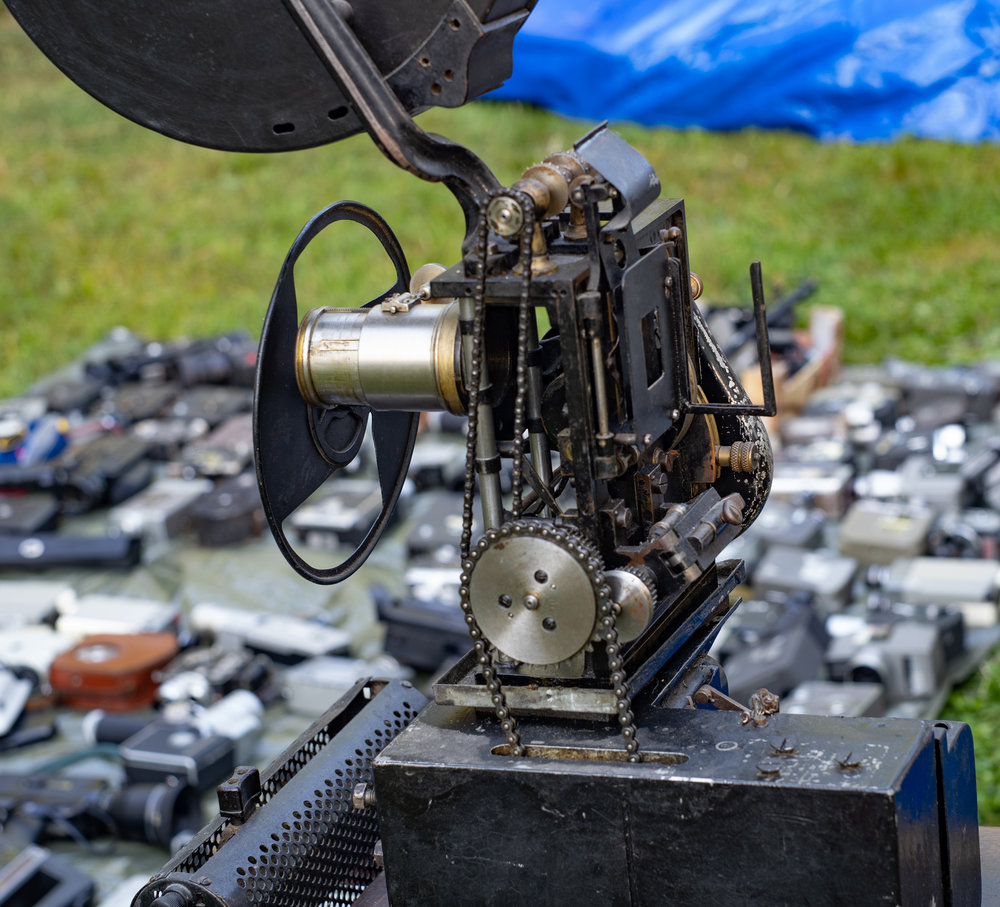
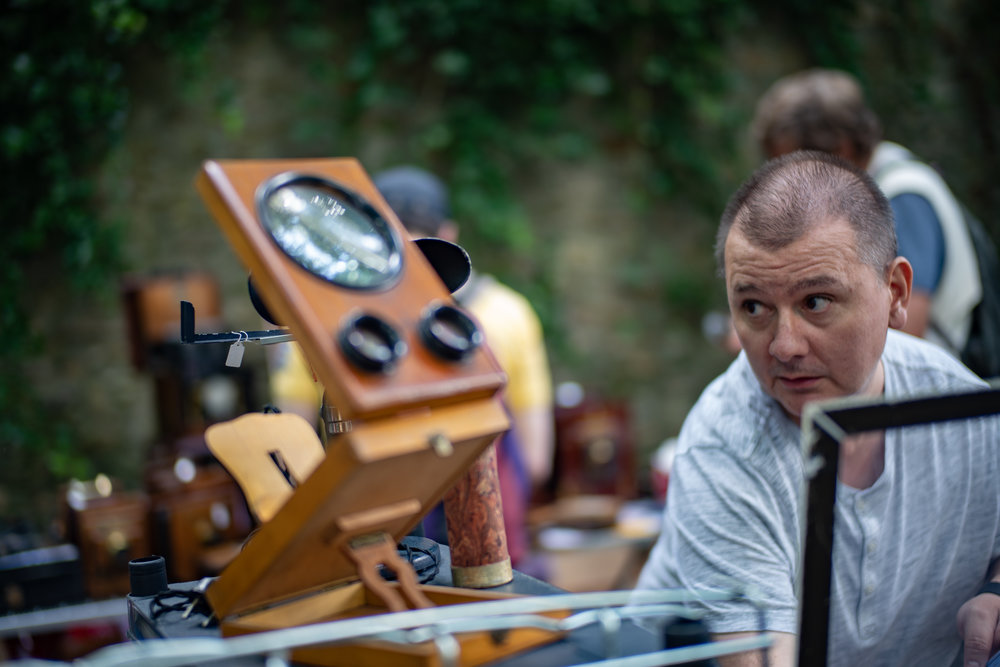
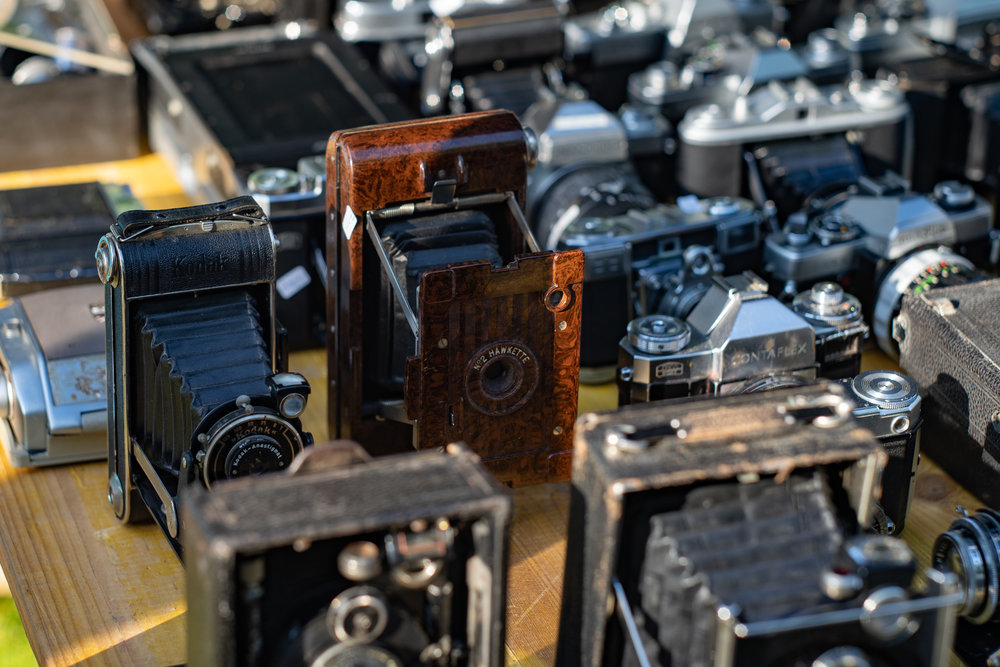
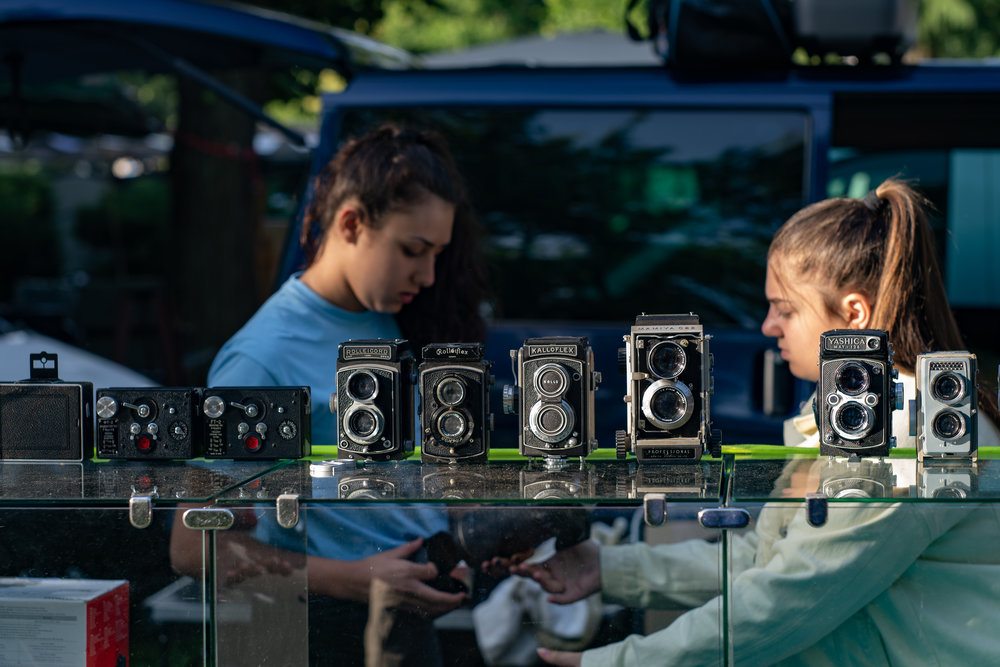
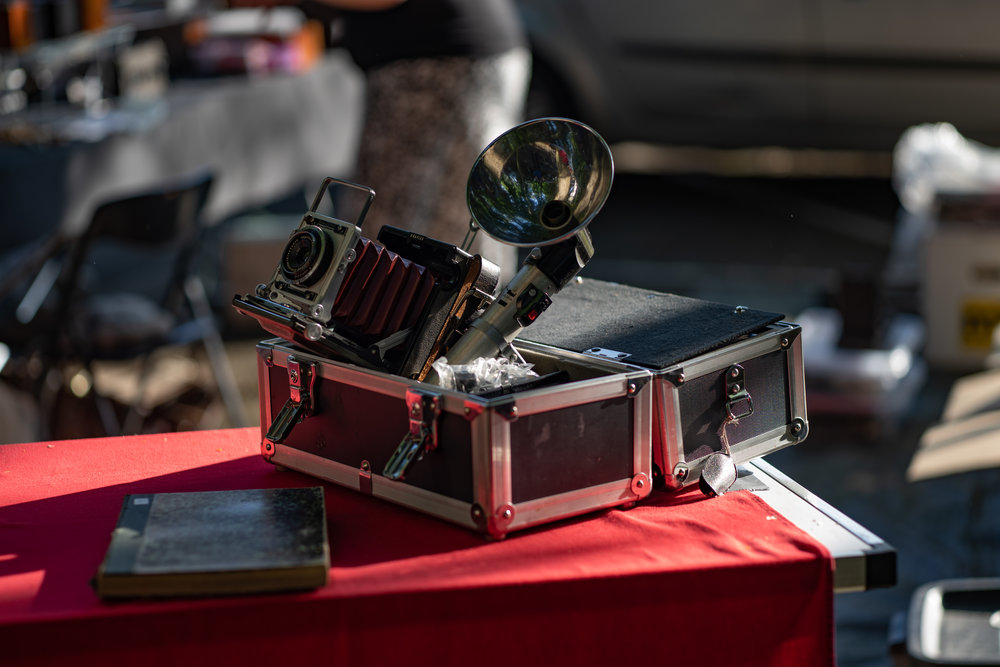
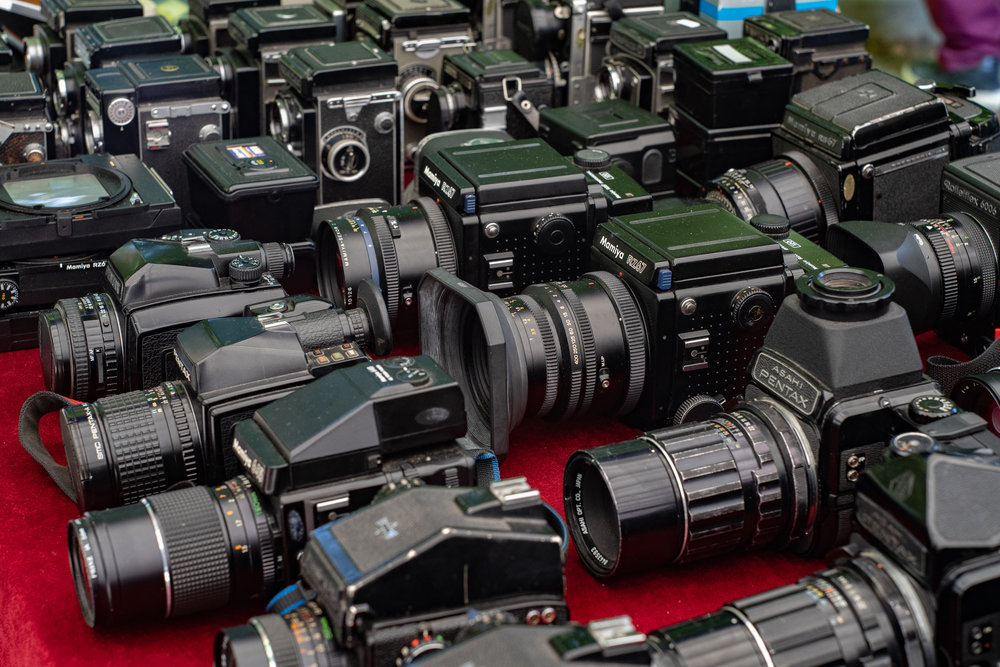
Datenschutz postscript
During the weekend I was struck by the number of people who wagged their fingers admonishingly at the sight of my camera. On several occasions, people came up and rather aggressively demanded I delete the previous shot. I did try to ask permission where possible, but in a crowded fair such as this, it is difficult to avoid faces intruding on the scene. This is a new and worrying phenomenon, especially at a photographic event where most people are supposedly used to the camera. I suspect it is a populist reaction to the new GDPR regulations (or, as the Germans say with typical precision, the Datenschutzgrundverordnung).
Whatever the reason, it doesn’t bode well for street photography. The negative reaction rather discouraged me from taking as many portrait shots as I would have liked. Perhaps in future, we will be restricted to architecture, landscape and still-life objects — such as old cameras and lenses. They don’t object, at least not until the European Union gives them the legal protection they really deserve.
__________

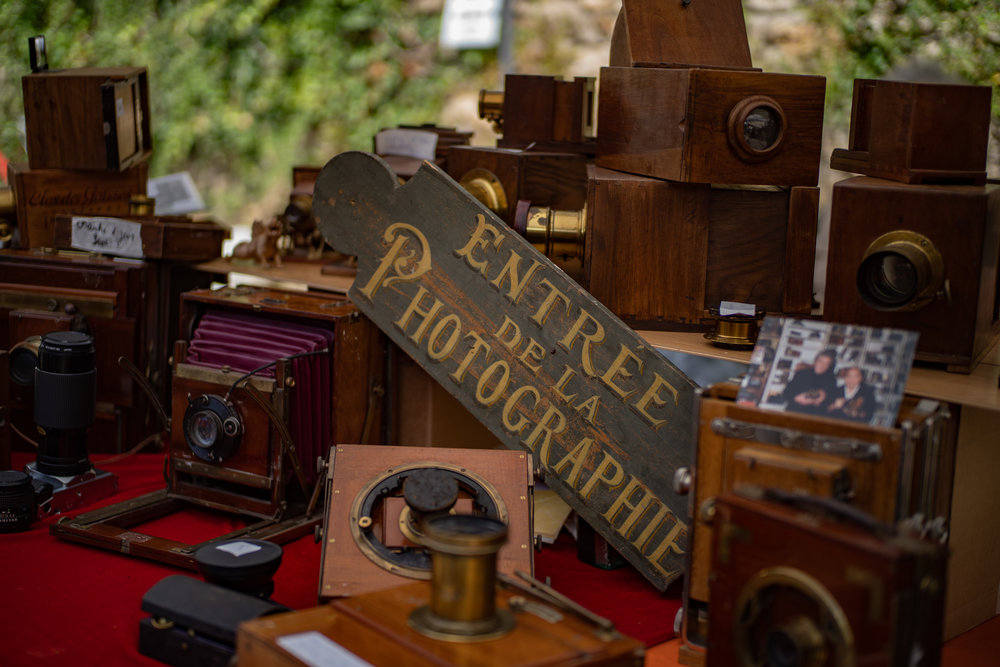
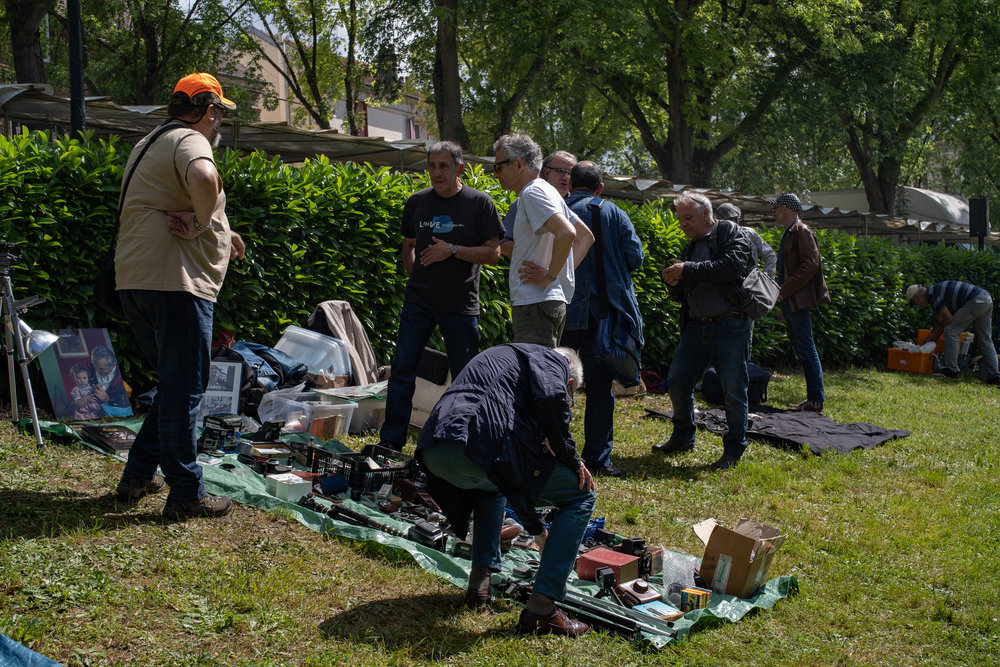
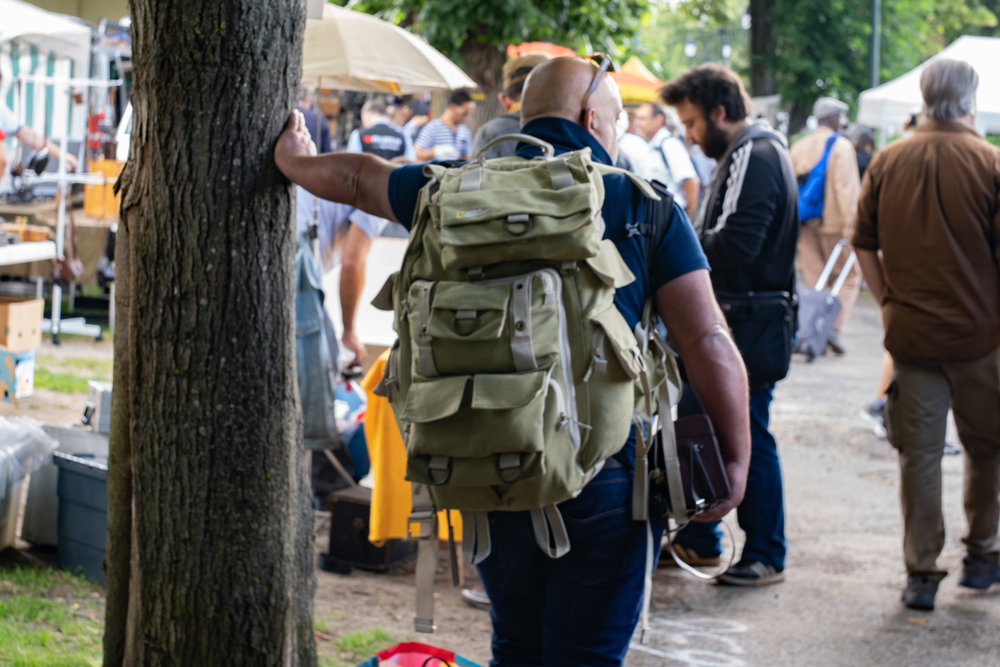
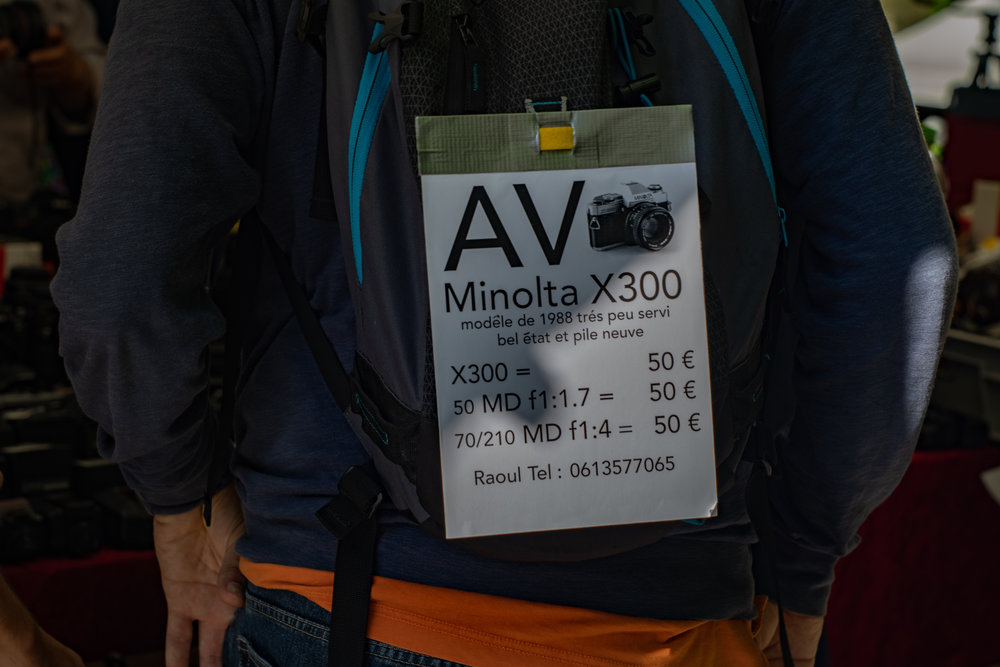
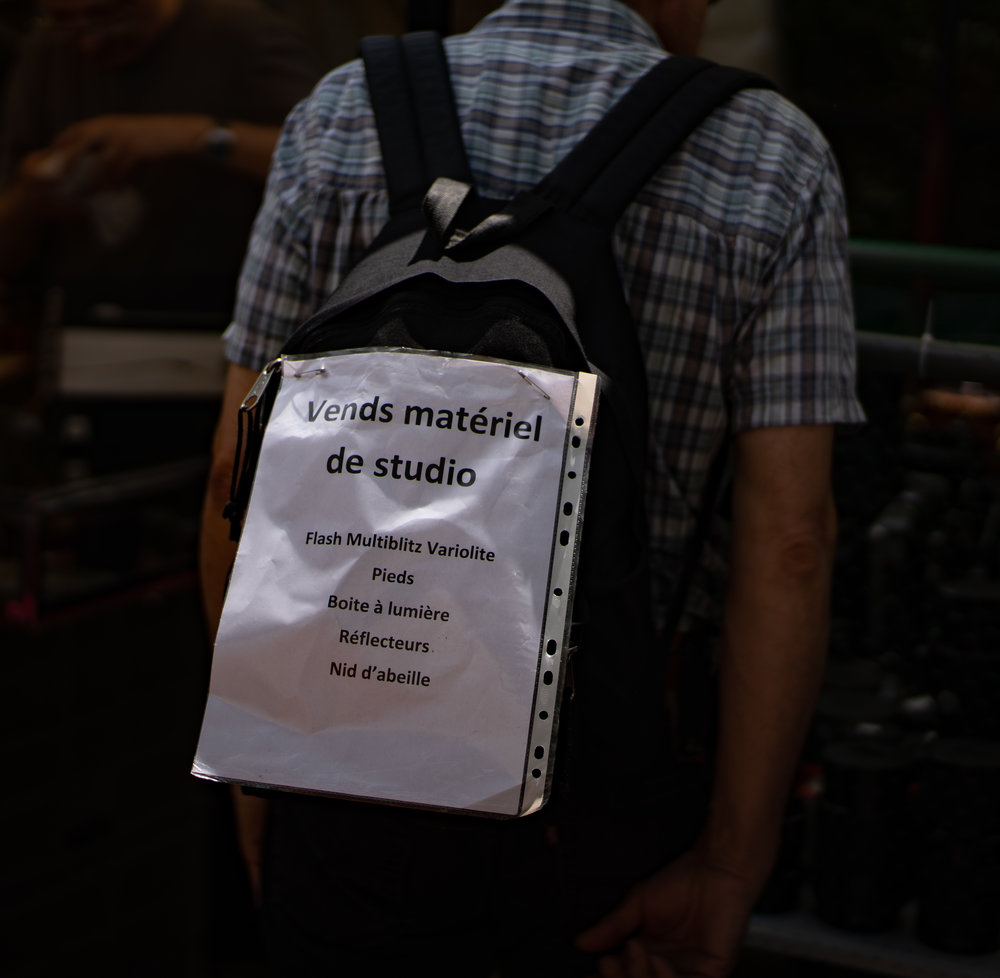
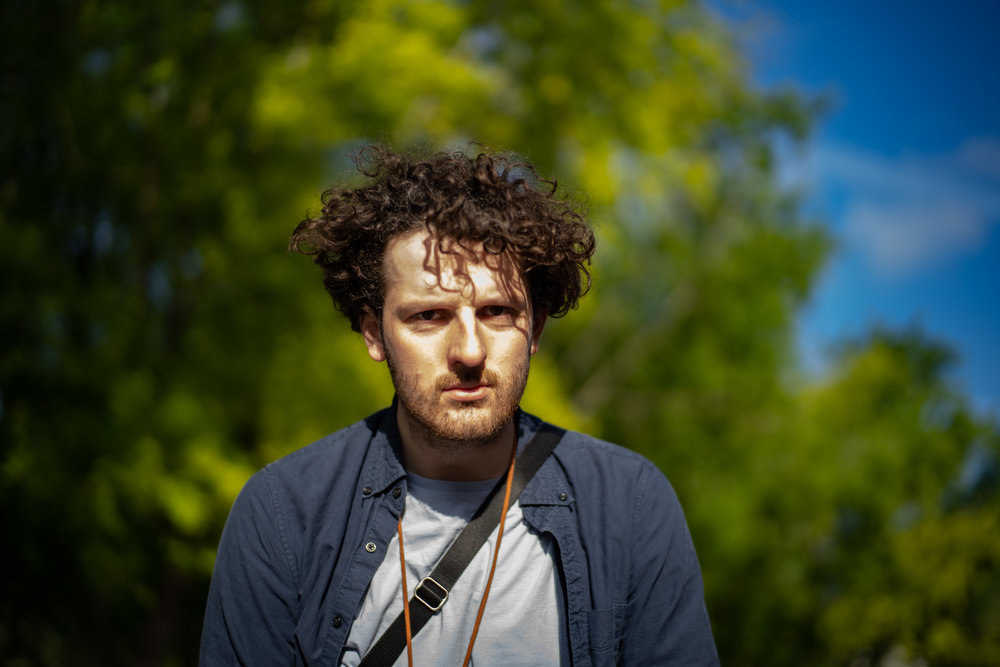
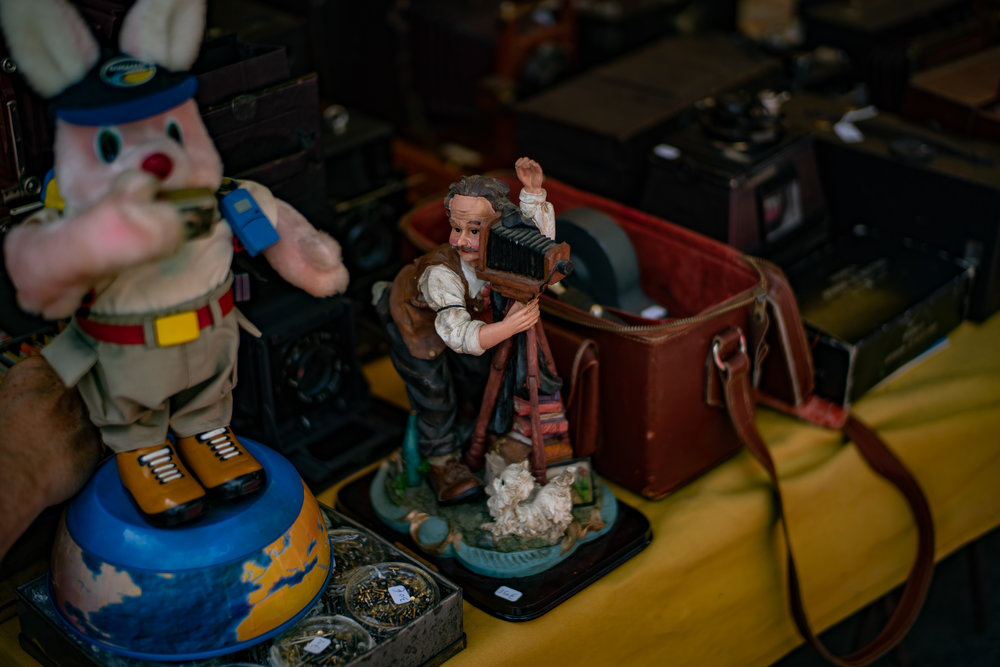
Nice report Mike, many thanks.
I have recently seen a picture by Eugene Atget that shows the Bièvres river in a beautiful pastoral setting, I suspect it is now from the look of the map, a suburb of Paris.
Seeing as we don’t discuss politics here, I won’t mention the stuff that the EU has lined up for bloggers and other users of the internet. Suffice to say, the GDPR is chicken feed.
There’s a lot of open countryside around Bièvres even now. It’s much less congested than an equivalent south-west London suburb which, I suppose, would be somewhere such as Esher at the same distance. Quite a nice part of the world to live, and within 30 minutes of Paris on the train (when they are running, but that’s another story).
At first glance thought postcard viewer man had Squirrel on his head!
Mike. I enjoyed your account and was not previously aware of the event.
I’m wondering whether the negative reaction of some people to being photographed stemmed, at least in part, from their knowledge of French privacy laws which are stricter than our own.
I take a lot of photographs in the "street" when I’m in France, and am mindful that I have no legal right to photograph an individual in a public place without consent, unlike here in the UK. Having said that and, as I understand it, groups of people may be acceptable as long as no one individual is the main subject.
I guess the reason for the objections would be various if the truth was known.
I am sure you are right. It’s just that I hadn’t really noticed it before and it was strange to have a number of not very pleasant encounters. One thing for sure, street photography isn’t going to get any easier. I think I’ll stick to flowers and cats as the safe option…..
This looks like an event I should attend at some time. As for getting bargains, unless you are a dealer like Ivor or Peter and are buying ‘in bulk’, the additional cost of getting there and staying nearby will easily offset the bargain price one might get. As you quite rightly say, the social side of the event is there to be enjoyed even if one does not buy anything.
I mentioned Grubb lenses last week. They are relatively rare and of twenty seven or so known to be ‘out there’ nowadays, I have two, a collector in the US who I came across on Macfilos has three and a member of the Grubb family and a friend on the Leica Forum have one each. A chat with the chap in the kilt, who is presumably well disposed towards ‘fellow Celts’, might give some guidance as to where more might be hidden.
As for folders, the bellows are the real issue. Early Kodaks have leather bellows which last, but later ones had paper and canvas bellows (to save costs) which did not last that well and they can be subject to light leaks. I believe that German made folders used leather (or leather like material) for longer and are more likely to be free from light leaks. There are various remedies for bellows with holes, including the careful use of ‘liquid tape’.
The I model above is a If from the early 1950s. The earlier Black Dial model is more rare, but the later and more common Red Dial Model has a better shutter. You pays your money etc
As for the ‘no no’ of taking photos, perhaps they thought that you were Inspector ‘Clouseau’ Evans from the French Revenue. The other possibility, leaving aside GDPR and social media etc, is that they do not approve of digital cameras. At out little collector’s circle in Dublin, it is an ‘unwritten rule’ that there is no discussion on digital cameras.
William
William, I did mention Grubb lenses and I think David Woodford found a couple. He knows a particular dealer, whose name escapes me, who has had several examples. You should speak to Woody about this.
Thanks Mike. A guy on the Large Format Photography Forum has put together a list of the known Grubb lenses and I have given him some help enlarging that list. I will get in touch with David.
William
I have a few friends who have encountered the same reaction on occasion when doing street work, as you outline above. However to date I haven’t thankfully, I have had a person refuse to be photographed on the street when I asked – but I have no issue with that, and I moved on to find another more willing subject – of which I did a few yards away. The last two festivals in Rochester have been easy going affairs, with people almost throwing themselves in front of the attending photographic crowd to have their presence imortalised.
As a Yorkshireman, I would judge the returning from a weekend away with a full wallet as a very large positive. In fact if only all weekends away could be the same.
Dave
My experience of asking people has been similarly positive. I reckon eight out of ten strangers will agree. The problem, though, is that they then pose like one of Mme Tussaud’s finest. But asking after the event is not very satisfactory.
My suggestion to your postscript, Mike, is a whole new line of business – angled viewfinders which would allow us to look as if we are looking in one direction while we photograph in another! From my childhood I remember a "spy" device called a seebackroscope (almost German!), so the idea is already there. You would need to equip your camera with a false lens, too, just to complete the illusion. The whole thing would probably be called a "Datenschutzumgehungsanordnung"!
I have one! It’s called a Winkelsucher and was made for Leicas in the 1930s for that very purpose. See this:
https://www.macfilos.com/photo/2016/4/16/leica-film-test-three-cameras-one-film-two-camera-nerds